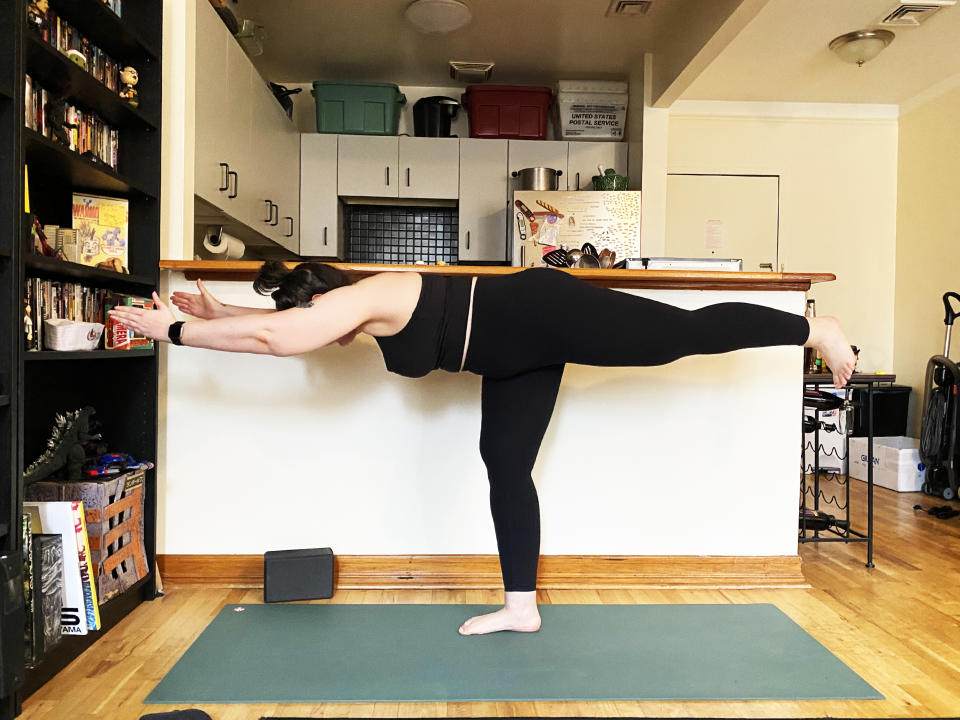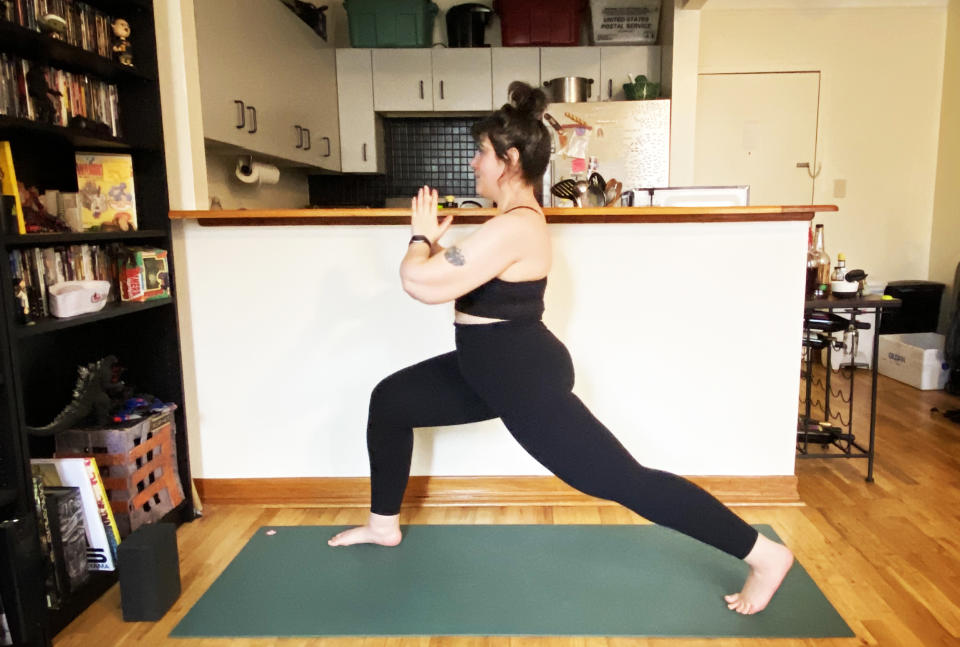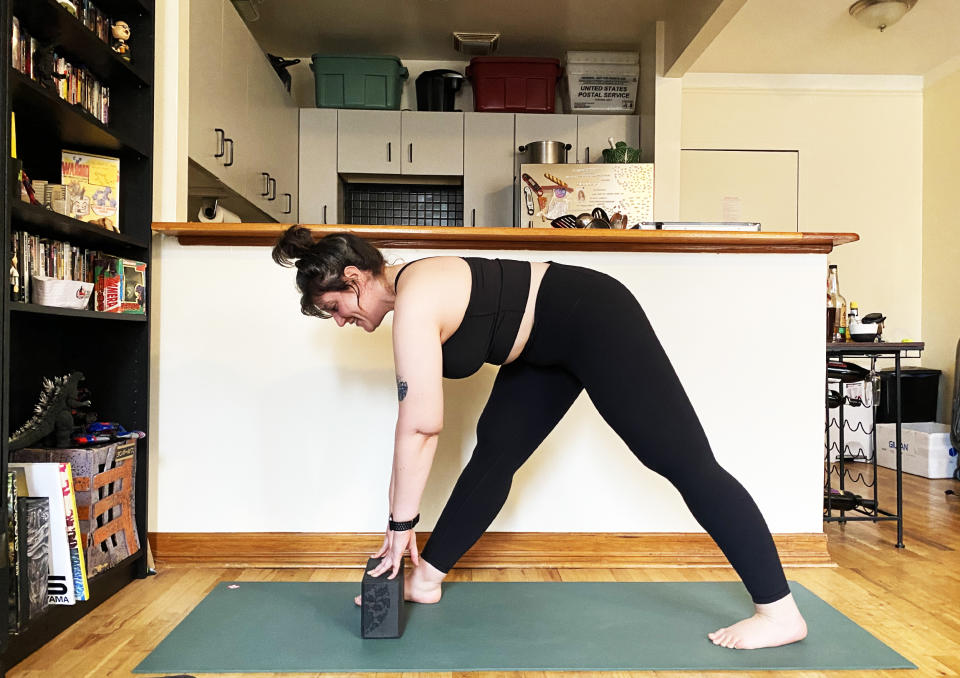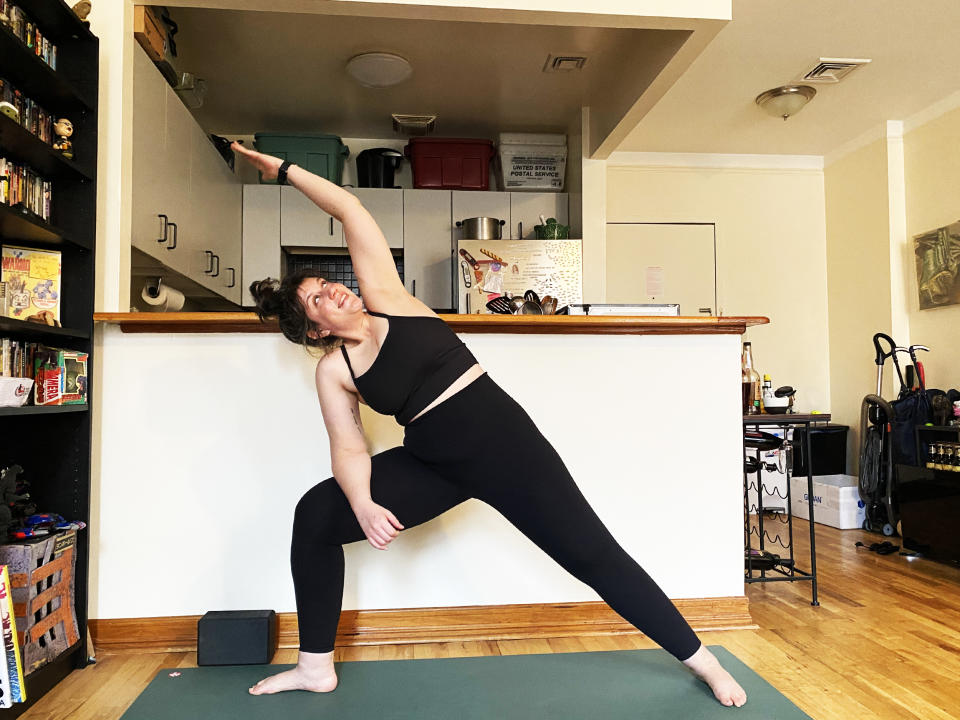I tried Y7’s new yoga platform — and it helped me commit to a regular yoga routine
I've been practicing yoga in some form or another for about 15 years — a fact I didn't even realize until sitting down to write this article. And that really sums up my approach to yoga: I always enjoy doing it and will always come back to it, but I almost never do it with any sense of regularity or intentionality.
Yoga is something I do on the weekends to stretch. I also do it during the week, mostly to work on mobility after my indoor cycling and strength training sessions. I do it because I find comfort and feel grounded in taking those familiar shapes while connecting with my breath and listening to music I enjoy.
But I rarely push myself to try new things or progress to more challenging versions of the poses I know well — even if I'm taking a class in person or via live stream. I had a hunch I wasn't really getting the most out of doing yoga in this way, mentally or physically. I didn't necessarily want to do yoga every single day, but I wanted a more structured routine, to use yoga to break up my work-from-home days and an incentive to try some new things.
So when trendy hot yoga brand Y7 Studio announced it would be launching a new online platform at the end of 2022, I took that as my opportunity to find a way to turn off autopilot and find a new way to fit the practice into my life.
The basics
In the signature Y7 class, the WeFlowHard Vinyasa, there are three vinyasa sequences that are each performed twice.
In the first round of each sequence, the instructor guides the class slowly so that everyone can find the proper alignment and get used to the flow. In the second round, each movement is tied to an inhale or exhale and the sequence moves much more quickly.
Depending on the pose, the slower round might actually be the more challenging one because it requires a lot of strength to hold some of these shapes for a long period of time.
At a Y7 studio in person, almost every class takes this hour-long format, which is performed in a candlelit heated room.
Keeping the format predictable was an intentional choice from the very beginning, Sarah Larson Levey, founder and CEO at Y7, tells TODAY.com. The idea came when Levey was on her own fitness journey following a nerve injury.

"The range of classes I was finding in every studio made it really hard for me to find a consistent practice," she says. Levey's inability to find a reliable class led her to focus on offering the predictable class format now known as WeFlowHard.
"I wanted people to have a great experience no matter what time of day they could come, no matter what their schedule looks like. I wanted them to be able to count on us," she says.
When the COVID-19 pandemic hit, Y7 hustled to create a way for people to take its classes at home at a time when they couldn't count on the traditional commuter schedule, Levey explains. The company uploaded videos that people could watch at home, but instructors had to clumsily ask people to start a playlist at home on their own devices at the right time in order for everything to sync up.
The new platform — which combined with the Y7 in-person classes is referred to as Y7 studio — keeps everything in one place, including clients' in-person and online booking information. It's also the result of an exclusive partnership with Universal Music Group, which allows instructors to create their own class playlists with an extensive library of songs to choose from.
The goal is not to replace IRL classes — that would be impossible, Levey says. Instead, the brand hopes to replicate the things they can and use the online extension to explore new possibilities that the at-home environment can bring, like shorter class formats.
The cost and platform
You have two choices to take part in Y7 Studio online classes. You can get unlimited access to just the digital classes for $20 per month. Or you can get unlimited digital classes along with discounted in-person classes (and other IRL perks) for $119 per month.
The $20 per month is on par with many other digital-only yoga-focused platforms, like CorePower Yoga, Alo Moves and Inner Dimension. Some major streaming fitness platforms, like Peloton and Apple Fitness+, offer yoga classes at a lower monthly price along with their other modalities, but yoga isn't their sole focus. And the ability to bundle your in-person classes with a digital subscription helps set the Y7 Studio options apart from those that only provide virtual subscriptions.
For now, digital classes are only available through a web browser. But the company tells TODAY.com that it's working on an updated app version that it expects to launch later in 2023.
Once you have an account, you'll just click over to the Browse tab to see all the classes available in the digital library. You can use the two sliders at the top of the page to select the length of the class and the level of intensity. Or you can choose from the four different class formats below: the 60-minute classic WeFlowHard Vinyasa, the 30- or 45-minute Power Vinyasa, the 45-minute Slow Burn and the 15-minute Focused Flow.
There are also many other filters on the left hand side of the screen, allowing you to see classes with specific instructors and playlist genres, or those that focus on a particular part of the body, for instance.
After you select a class, another window pops up with more information, including a description of the class format, the "sweat level" and the full playlist for that particular session.
After you hit play, the class will start with a short introduction from the instructor, who tells you a little about themselves and what to expect in the class. All the classes are pre-recorded, so you can hit pause as needed. And there are toggles to adjust the volume for the instructor's voice and the music separately.
Once the class is over, it will automatically go into your "classes I've taken" list, which you can filter in or out in the future.
My experience
I was gifted a one-month membership to Y7 Studio, which allowed me to take unlimited classes online. I took a dozen classes in about three weeks, and initially I found myself gravitating towards the 30- and 45-minute classes most of the time.
For my first class, I went with a 45-minute Slow Burn focusing on lower back stability. This felt like a good introduction to the ladder format and, even at what Y7 considers a moderate sweat level, I was dripping by the end.

I loved seeing the instructor in this class calling out modifications and places to use props — and then actually take those modifications and use those props themself! It's tempting to fall into the trap of thinking these different options are "the easy way out" rather than simply "the right way to do these poses for me at this moment."
When the instructor does it along with you rather than just saying the words, it feels like you have permission to do it too. As someone who frequently uses modifications and props due to a neck and shoulder injury and the other quirks of my body, it was really refreshing.
When I finally took my first full-hour class, I could tell that's where the Y7 Studio format really shines. The sequences felt innovative and I appreciated that the instructor explained why we warmed up with specific shapes and how they would help us later. This helped me think of my anatomy a little differently and I started to view my muscles and limbs as tools more easily.
I also really surprised myself by going for poses I'd never encountered before — who knew I had toppling tree pose hiding in my repertoire?! It was a nice reminder that we're often a lot stronger than we think, and it made me more confident to try other new-to-me poses.
The shorter classes, which ranged from 15 to about 25 minutes long, were nice little bite-sized bits of movement that were easy to fit into my days. Rather than two or three sequences, there is typically just one sequence, sometimes repeated, or a single peak pose that the entire flow builds towards.
But don’t let the shorter class length fool you: These can still be really challenging. And I actually found the most creative sequences in the shorter classes. In fact, later in my testing period, I liked taking two or three 15-minute classes back-to-back to get more variety. Plus, it gave me an excuse to double-down on Shavasana. Win-win.
Even with a shorter class time, the instructors don't skimp on the warm-up and cool-down periods. As someone who is often coming to the mat straight from my desk at home, having a robust transition is really helpful to get into the right mindset.
Throughout my few weeks with Y7 Studio, I sweat a lot and felt sore a lot of the time — in the best way. As someone who typically exercises in the evenings after work, it was nice to have an excuse to get some movement in earlier in the day without needing to go outside on frigid days.
Two or three times a week, it became a habit to grab my water, light a candle and dim the lights in my living room before starting a Y7 video. Even if it was only 15 minutes, it felt great to connect with my body more regularly in this way.
I ended every class feeling strong and grounded, even if there were some struggles along the way. Sometimes, I learned to just admit to myself that I didn't love a pose or I had to skip something because I knew it would aggravate my nerve injury, and that was fine. Maybe there was a variation that I prefer to take instead. But either way, it's not the end of the world.
Other times, I saw challenging moments as a starting point. And, even if a shape was a struggle the first time or my transition between poses was wobbly, I worked to reframe my frustration as an invitation to try again next time. Or, honestly, sometimes I just laughed and moved on.
What I liked
The instructors really make or break Y7's online classes both literally and figuratively. And, in my experience, the Y7 instructors made yoga a fun, encouraging yet challenging experience.
The Y7 vibe is all about keeping it real and not taking ourselves too seriously. And the instructors have a level of self-awareness that instructors rarely get to express in online yoga. They make jokes, take breathers and use props during class and they even occasionally stumble during balance poses — just like me!

In fact, the classes felt so authentic that multiple times I forgot I was watching a recorded video that I could pause and not a lives tream.
During one particularly challenging sequence, the also-out-of-breath instructor told us to just take a beat and smile. Normally, this would have gotten an eye-roll from me, but in the moment it was exactly what I needed: an acknowledgment that what we were doing was genuinely hard, but I wasn't doing it by myself — and, more than anything, it's supposed to be enjoyable.
In another class, the instructor had us do chair pose after chair pose. In fact, the Sanskrit name for chair pose is Utkatasana, which more accurately translates to "fierce pose" or "awkward pose." It was grueling, but I had a good chuckle when I heard her call out, "This is the last chair pose, if that means anything to you." Reader, it meant a lot to me — and made me feel like someone out there genuinely saw and appreciated how much work I was putting in.
"It's really about making it as live and as transparent and as raw as possible," Chris Stanley, an instructor at Y7 who teaches online and in-person classes, tells TODAY.com.
Stanley confides that, in the introduction for one video, he listed the studio locations he works at incorrectly— and it was left in the final cut "because that's something that would happen live," he says.
With repeated sequences and building flows, there's a predictable backbone to the format of each class. You always know where you're going and the basic structure of the class. You don't want to skip ahead, of course, but it helps to know what's coming. And, at home, you have the ability to pause if something isn't working for you or you fall out of a pose and get behind.
"When I teach, I really emphasize to just take your time if something’s not quite landing immediately, there’s no rush," Stanley says. Taking that message to heart, I paused more than once when I fell out of a pose and got behind as well as when a stretch felt really nice and I wanted to hold it a bit longer.
One area where the online classes really stand out is the variety of class lengths. Y7 studios generally only offer their signature 45- or 60-minute classes. But, at home, you can take classes as short as 15, 20 or 30 minutes. Even with that short format, there's always time for a warmup and cooldown.
Stanley, who is also a professional trumpet player, likens the class creation process to songwriting. And the shorter class formats gave instructors, who became used to the luxury of a full hour, a new creative challenge, he says. For the record, instructors also create the individual playlists for each class.
What I didn't like
The predictable format of Y7 classes became both a benefit and a drawback for me.
On one hand, as mentioned above, I enjoy knowing generally what I'm going to get in every class before I hit play. But on the other hand, the fact that many classes follow more or less the same steps and that many of them incorporate the same poses on your way to a peak shape got a bit old.
Technically, there are four different Y7 Studio class formats. But the most distinguishing feature of each of them, for me, was just the length of the class. So if Y7 was the only workout I was doing for an extended period of time, I could see it getting a little stale. For me, switching things up by taking a few shorter classes back to back helped keep it fresh.
I am grateful that this feeling also encouraged me to investigate a little more deeply why I find some sequences to be a chore. I realized that, often, it's because my familiarity with them leads me to either zone out or put more pressure on myself to be perfect with alignment. Whereas, if something is new, I pay more attention and give myself more grace to make mistakes.
That mindset is something I'll work to adjust in future classes, for sure. I want to remind myself that no one is grading me. No one can even see me if I'm practicing at home. And perfection is always impossible, as multiple Y7 instructors reiterated to me through my laptop screen. Whether a pose is new to me or one of my favorites, all I can really do is feel it out and work with my body to progress when the time is right — without judgment about when that might be.

I also wish there had been more variety when it came to the playlists. Both in-person and digital Y7 classes usually stick to a hip-hop, pop or R&B playlist highlighting big-name artists, which is fun for a while but wasn't always my thing. I’m a certified heavy metal weirdo, which I know is hard to find in most workout classes across the board.
Music is a highly personal thing, and to be clear, I was never turned off by anything we listened to during my classes. But there were a few times when the music didn't really fit the vibe, like hearing the fast-paced song that — I assume — was chosen for the final push of the workout bleed into the chill cooldown period. In those moments, the music became more of a distraction when I wanted to be focusing on how good it felt to relax into child's pose after a tough workout.
Most of the time I was concentrating too hard on the flow and my breathing to really even notice the songs. But if the song choices really bother you, you could always turn the music off completely and play your own stuff in the background instead.
I'd recommend this workout to:
Yoga newbies who want the direction, space and time to nail their form in every class
More experienced yogis who want to try out new poses in a predictable, reliable format
Those trying to fit more mobility, flexibility or strength work into a busy schedule
Fans of Y7 who want to keep up their practice at home or who don't live near a studio
Anyone who's been curious to try a Y7 class without the signature heated room
This article was originally published on TODAY.com

